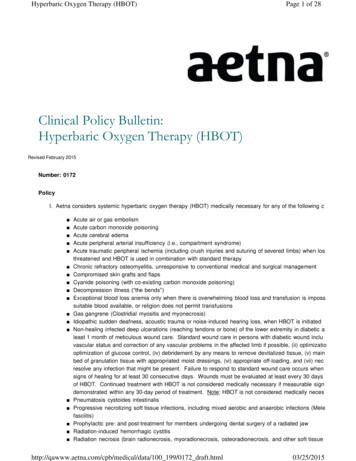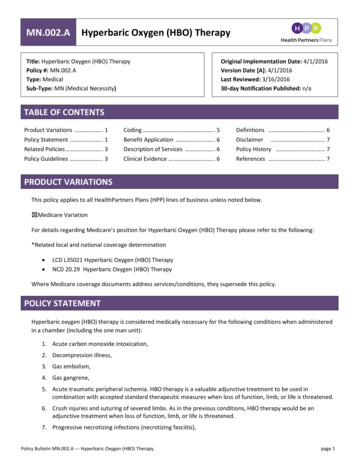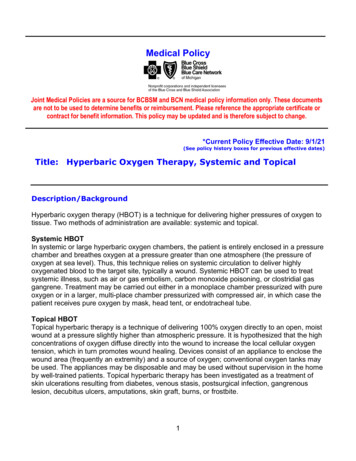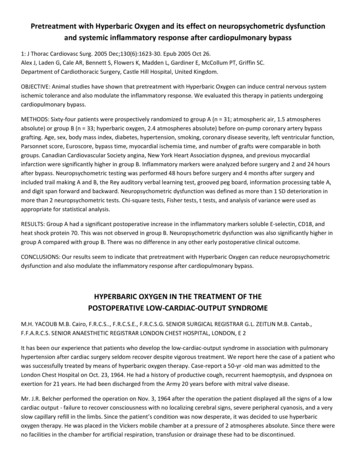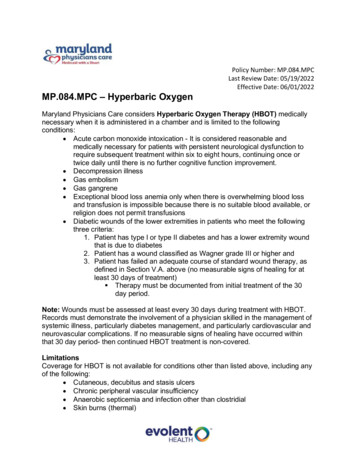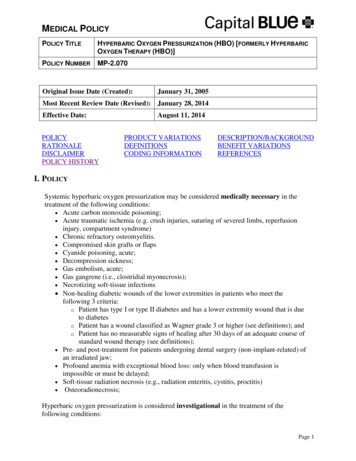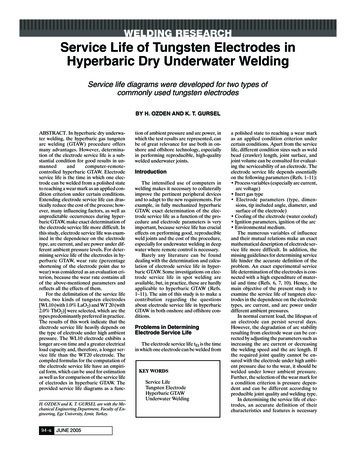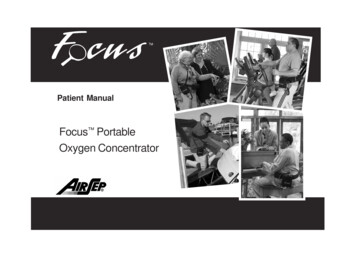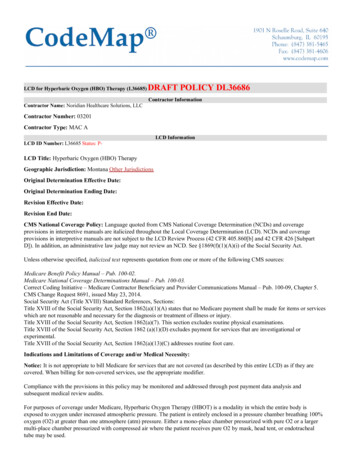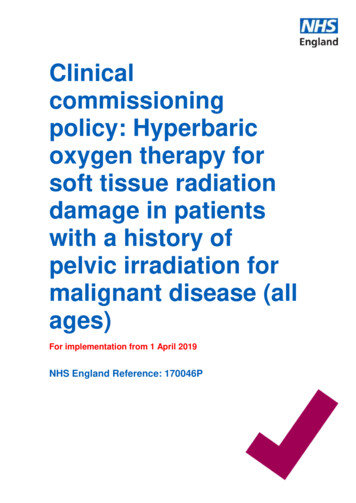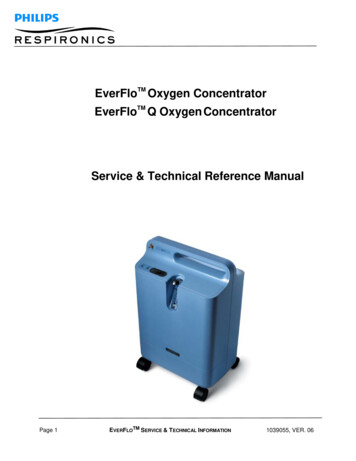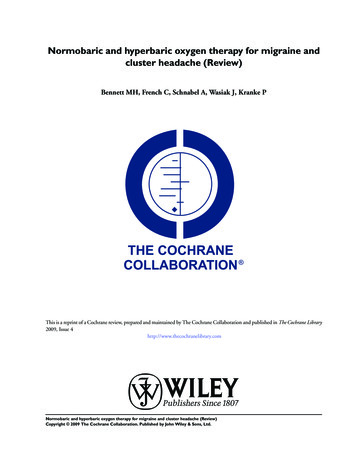
Transcription
Normobaric and hyperbaric oxygen therapy for migraine andcluster headache (Review)Bennett MH, French C, Schnabel A, Wasiak J, Kranke PThis is a reprint of a Cochrane review, prepared and maintained by The Cochrane Collaboration and published in The Cochrane Library2009, Issue 4http://www.thecochranelibrary.comNormobaric and hyperbaric oxygen therapy for migraine and cluster headache (Review)Copyright 2009 The Cochrane Collaboration. Published by John Wiley & Sons, Ltd.
TABLE OF CONTENTSHEADER . . . . . . . . . . . . . . . . . . . . . . . . . . . . . . . . . . . . . . .ABSTRACT . . . . . . . . . . . . . . . . . . . . . . . . . . . . . . . . . . . . . .PLAIN LANGUAGE SUMMARY . . . . . . . . . . . . . . . . . . . . . . . . . . . . . .BACKGROUND . . . . . . . . . . . . . . . . . . . . . . . . . . . . . . . . . . . .OBJECTIVES . . . . . . . . . . . . . . . . . . . . . . . . . . . . . . . . . . . . .METHODS . . . . . . . . . . . . . . . . . . . . . . . . . . . . . . . . . . . . . .RESULTS . . . . . . . . . . . . . . . . . . . . . . . . . . . . . . . . . . . . . . .DISCUSSION . . . . . . . . . . . . . . . . . . . . . . . . . . . . . . . . . . . . .AUTHORS’ CONCLUSIONS . . . . . . . . . . . . . . . . . . . . . . . . . . . . . . .ACKNOWLEDGEMENTS. . . . . . . . . . . . . . . . . . . . . . . . . . . . . . . .REFERENCES . . . . . . . . . . . . . . . . . . . . . . . . . . . . . . . . . . . . .CHARACTERISTICS OF STUDIES . . . . . . . . . . . . . . . . . . . . . . . . . . . . .DATA AND ANALYSES . . . . . . . . . . . . . . . . . . . . . . . . . . . . . . . . . .Analysis 1.1. Comparison 1 HBOT for acute migraine attack, Outcome 1 Substantial acute relief of headache. . .Analysis 1.2. Comparison 1 HBOT for acute migraine attack, Outcome 2 Proportion requiring rescue medication. .Analysis 1.3. Comparison 1 HBOT for acute migraine attack, Outcome 3 Rescue medication - best case scenario. .Analysis 1.4. Comparison 1 HBOT for acute migraine attack, Outcome 4 Rescue medication - worst case scenario. .Analysis 1.5. Comparison 1 HBOT for acute migraine attack, Outcome 5 Proportion with nausea and vomiting. . .Analysis 1.6. Comparison 1 HBOT for acute migraine attack, Outcome 6 Nausea and vomiting - best case scenario.Analysis 1.7. Comparison 1 HBOT for acute migraine attack, Outcome 7 Nausea and vomiting - worst case scenario.Analysis 1.8. Comparison 1 HBOT for acute migraine attack, Outcome 8 Pain intensity score immediately followingtherapy (VAS 0 to 10). . . . . . . . . . . . . . . . . . . . . . . . . . . . . . . .Analysis 2.1. Comparison 2 HBOT for the prevention of migraine, Outcome 1 Headache days per week. . . . .Analysis 3.1. Comparison 3 HBOT for acute cluster headache, Outcome 1 Complete relief of headache (during therapy).Analysis 3.2. Comparison 3 HBOT for acute cluster headache, Outcome 2 Relief for 48 hours. . . . . . . . .Analysis 4.1. Comparison 4 HBOT for prevention of cluster headache, Outcome 1 Proportion with a reduction of headacheindex of 50% in the week following therapy. . . . . . . . . . . . . . . . . . . . . . . .Analysis 5.1. Comparison 5 NBOT for acute cluster headache, Outcome 1 Complete relief of headache (during therapy).Analysis 5.2. Comparison 5 NBOT for acute cluster headache, Outcome 2 Degree of relief immediately following therapy(0 no relief, 3 complete relief ). . . . . . . . . . . . . . . . . . . . . . . . . .FEEDBACK . . . . . . . . . . . . . . . . . . . . . . . . . . . . . . . . . . . . . .WHAT’S NEW . . . . . . . . . . . . . . . . . . . . . . . . . . . . . . . . . . . . .HISTORY . . . . . . . . . . . . . . . . . . . . . . . . . . . . . . . . . . . . . . .CONTRIBUTIONS OF AUTHORS . . . . . . . . . . . . . . . . . . . . . . . . . . . . .DECLARATIONS OF INTEREST . . . . . . . . . . . . . . . . . . . . . . . . . . . . . .SOURCES OF SUPPORT . . . . . . . . . . . . . . . . . . . . . . . . . . . . . . . . .INDEX TERMS. . . . . . . . . . . . . . . . . . . . . . . . . . . . . . . . . . . .Normobaric and hyperbaric oxygen therapy for migraine and cluster headache (Review)Copyright 2009 The Cochrane Collaboration. Published by John Wiley & Sons, 030313132323333i
[Intervention Review]Normobaric and hyperbaric oxygen therapy for migraine andcluster headacheMichael H Bennett1 , Christopher French2 , Alexander Schnabel3 , Jason Wasiak4 , Peter Kranke51 Departmentof Anaesthesia, Prince of Wales Hospital, Randwick, Australia. 2 Department of Neurology, Prince of Wales Hospital,Randwick, Australia. 3 Department of Anesthesiology and Intensive Care, University Hospital Münster, Münster, Germany. 4 VictorianAdult Burns Service, The Alfred Hospital, Melbourne, Australia. 5 Department of Anaesthesiology, University of Würzburg, Würzburg,GermanyContact address: Michael H Bennett, Department of Anaesthesia, Prince of Wales Hospital, Barker Street, Randwick, NSW, 2031,Australia. m.bennett@unsw.edu.au.Editorial group: Cochrane Pain, Palliative and Supportive Care Group.Publication status and date: Edited (no change to conclusions), published in Issue 4, 2009.Review content assessed as up-to-date: 6 May 2008.Citation: Bennett MH, French C, Schnabel A, Wasiak J, Kranke P. Normobaric and hyperbaric oxygen therapy for migraine and clusterheadache. Cochrane Database of Systematic Reviews 2008, Issue 3. Art. No.: CD005219. DOI: 10.1002/14651858.CD005219.pub2.Copyright 2009 The Cochrane Collaboration. Published by John Wiley & Sons, Ltd.ABSTRACTBackgroundMigraine and cluster headaches are severe and disabling. Migraine affects up to 18% of women, while cluster headaches are much lesscommon (0.2% of the population). A number of acute and prophylactic therapies are available. Hyperbaric oxygen therapy (HBOT)is the therapeutic administration of 100% oxygen at environmental pressures greater than one atmosphere, while normobaric oxygentherapy (NBOT) is oxygen administered at one atmosphere.ObjectivesTo assess the safety and effectiveness of HBOT and NBOT for treating and preventing migraine and cluster headaches.Search methodsWe searched the following in May 2008: CENTRAL, MEDLINE, EMBASE, CINAHL, DORCTIHM and reference lists from relevantarticles. Relevant journals were hand searched and researchers contacted.Selection criteriaRandomised trials comparing HBOT or NBOT with one another, other active therapies, placebo (sham) interventions or no treatmentin patients with migraine or cluster headache.Data collection and analysisThree reviewers independently evaluated study quality and extracted data.Main resultsNine small trials involving 201 participants were included. Five trials compared HBOT versus sham therapy for acute migraine, twocompared HBOT to sham therapy for cluster headache and two evaluated NBOT for cluster headache.Pooling of data from three trials suggested that HBOT was effective in relieving migraine headaches compared to sham therapy (relativerisk (RR) 5.97, 95% confidence interval (CI) 1.46 to 24.38, P 0.01). There was no evidence that HBOT could prevent migraineNormobaric and hyperbaric oxygen therapy for migraine and cluster headache (Review)Copyright 2009 The Cochrane Collaboration. Published by John Wiley & Sons, Ltd.1
episodes, reduce the incidence of nausea and vomiting or reduce the requirement for rescue medication. There was a trend to betteroutcome in a single trial evaluating HBOT for the termination of cluster headache (RR 11.38, 95% CI 0.77 to 167.85, P 0.08), butthis trial had low power.NBOT was effective in terminating cluster headache compared to sham in a single small study (RR 7.88, 95% CI 1.13 to 54.66, P 0.04), but not superior to ergotamine administration in another small trial (RR 1.17, 95% CI 0.94 to 1.46, P 0.16). Seventy-six percent of patients responded to NBOT in these two trials.No serious adverse effects of HBOT or NBOT were reported.Authors’ conclusionsThere was some evidence that HBOT was effective for the termination of acute migraine in an unselected population, and weakevidence that NBOT was similarly effective in cluster headache. Given the cost and poor availability of HBOT, more research shouldbe done on patients unresponsive to standard therapy. NBOT is cheap, safe and easy to apply, so will probably continue to be useddespite the limited evidence in this review.PLAIN LANGUAGE SUMMARYNormal pressure oxygen therapy and hyperbaric oxygen therapy for migraine and cluster headachesMigraine and cluster headaches are severe and disabling. Both hyperbaric oxygen therapy (HBOT) and normal pressure oxygen therapy(NBOT) have been suggested as effective treatments to end acute attacks and prevent future attacks. HBOT involves people breathingpure oxygen in a specially designed chamber. In our review, we found some weak evidence to suggest that HBOT helps people with acutemigraine headaches and possibly cluster headaches, and that NBOT may help people with cluster headache. We found no evidencethat either can prevent future attacks. Because many migraines can be treated simply with appropriate drug therapy, further research isneeded to help choose the most appropriate patients (if any) to receive HBOT.BACKGROUNDMigraine and cluster headache are disabling health problemsamong adults. Both types of headache are frequently severe and associated with features other than pain (IHS 2004). While the classification of headaches is complex, migraine and cluster headachesare generally distinguished by the nature of associated symptoms(nausea, vomiting and photophobia occur commonly with migraine, while cluster headaches are typically accompanied by tearing and nasal congestion), the pattern in which they occur (clusterheadaches typically occur daily for up to several weeks before resolving, often for lengthy periods) and their location and character(cluster headaches are periorbital and unilateral, while migrainesmay be bilateral and are often described as throbbing). Migrainemay be preceded by an aura - most often a visual disturbance - insome people.Migraine is the more common of the two: surveys from the U.S.and elsewhere suggest that 6% to 7% of men and 15% to 18% ofwomen experience migraine headaches, while about 0.2% of thepopulation suffer with cluster headache (Mathew 2001; Russell2004). First-degree relatives of those with cluster headaches are 5to 18 times more likely to have such headaches than individuals inthe general population. The mechanisms involved in both typesof headache continue to be active areas of research (Hamel 1999;Leone 2004). Migraine results in significant disability and workloss (Burton 2002; Edmeads 2002; Lipton 2001); estimated aggregate indirect costs to employers in the U.S. for reduced productivity due to migraine range from U.S. 5.6 billion to U.S. 17.2billion annually (Hu 1999; Osterhaus 1992). The social and economic impact of cluster headache is less clear.Therapy for headache falls into two categories: acute and preventive. Acute therapy aims at the symptomatic treatment of the headpain and other symptoms associated with an acute attack or cluster. The goal of preventive therapy is to reduce the frequency and/or intensity of attacks and thereby improve patient functioningand quality of life. Preventive therapy is especially well-suited topatients with very frequent or severe attacks, significant headacherelated disability or resistance to acute therapy.Normobaric and hyperbaric oxygen therapy for migraine and cluster headache (Review)Copyright 2009 The Cochrane Collaboration. Published by John Wiley & Sons, Ltd.2
There are many accepted drug therapies for acute migraine, including non-specific analgesics such as non-steroidal anti-inflammatory drugs, and specific agents such as sumatriptan, ergotamineand dihydroergotamine (DHE) (Geraud 2004). These drugs areeffective in the majority of cases, although it is not uncommon forheadache to recur within 48 hours (Bateman 1993). Most peoplewith migraine are able to manage even these recurrent headachessuccessfully at home with self-administered medication. Thus,while migraine is a common problem, the number of cases unresponsive to accepted therapeutic approaches may be quite small.It is these patients who may benefit from a therapy delivered at ahealth facility, such as intravenous DHE, parenteral analgesics orantinauseants or, potentially, hyperbaric oxygen therapy.Pharmacological and non-pharmacological therapies used for theprevention of migraine include various beta-blockers, amitriptyline, sodium valproate, gabapentin, relaxation, biofeedback andcognitive-behavioural therapy (Geraud 2004). Again, while mostpatients respond to such therapies, they are not always effective.Refractory patients may be offered preventive drug treatmentswith potentially serious toxicities, such as methysergide; these patients may also be candidates for other resource-intensive treatments such as hyperbaric oxygen therapy.The standard acute treatment for cluster headache is sumatriptan and inhalation of 100% oxygen, while a number of agentshave been used for prophylaxis including ergotamine, verapamil,lithium and steroids (Ekbom 2002). Again, most patients respondwell to the administration of specific acute therapy. For example, inone randomised study, 74% of attacks responded to subcutaneoussumatriptan within 15 minutes (Ekbom 1993). Only a subset ofcluster headache patients would therefore be candidates for the administration of therapies such as hyperbaric oxygen where hospitalattendance is required. Most recently, there have been promisingadvances in the search for a more permanent cure, particularlywith deep hypothalamic stimulation techniques and subsequentsurgical procedures (May 2003).This review considers the evidence for the effectiveness and safety of oxygen administration for migraine or cluster headache.It includes both the use of oxygen at high percentage of normalatmospheric pressure (normobaric oxygen therapy (NBOT)) andthe use of 100% oxygen at pressures above one atmosphere (hyperbaric oxygen therapy (HBOT)). We will consider oxygen bothas an acute therapy for terminating individual attacks and as a preventive therapy for reducing the frequency of headache episodes.NBOT has been used with some success to treat both migraine andcluster headaches for many years (Alvarez 1939; Kudrow 1981),presumably through the ability of oxygen to constrict distal cerebral resistance vessels (Drummond 1985; Iversen 1990). The observation that oxygen administered at higher pressures producedeven further vasoconstriction (with preservation of tissue oxygenation) led directly to the suggestion that HBOT might favourablyinfluence vascular headache resistant to conventional drug ther-apy (Fife 1994). More recently, it has been suggested that HBOTmay also exert therapeutic effects through the action of oxygen asa serotonergic agonist and an immunomodulator of response tosubstance P (a short chain neuropeptide involved in pain signaltransmission) (Di Sabato 1996; Di Sabato 1997). Indeed, whileacknowledging that vascular mechanisms are involved, it has beensuggested that inflammation plays a critical role in the genesis of amigraine episode (Goadsby 1997; Hamel 1999). If this is correct,then the well-described moderation of inflammatory pathways byHBOT may both influence acute attacks and provide useful prophylaxis (Slotman 1998; Sumen 2001).Clinically, HBOT has been reported as a successful treatment forheadache since at least 1989 (Fife 1989; Weiss 1989), and sporadicreports have followed since that time, including some comparativetrials. On the other hand, oxygen in high doses may increase oxidative stress through oxygen free radical species and is potentiallytoxic (Yusa 1987). Indeed, the brain is particularly at risk (Clark2003). For this reason, it is appropriate to postulate that in somemigraine or cluster headache patients, HBOT may do more harmthan good.Precautions against fire are required and standard practice in areaswhere oxygen is in use. Prolonged administration to prematureneonates may be implicated in the development of retinopathy ofprematurity, and oxygen has produced respiratory arrest in chronically hypercarbic patients relying on an hypoxic drive for respiration. Neither of these groups of individuals is likely to be relevant in this review. Regardless of the particular pathology beingtreated, HBOT is associated with some risk of adverse effects, including damage to the ears, sinuses, and lungs from the effects ofpressure; temporary worsening of shortsightedness; claustrophobia; and oxygen poisoning. Although serious adverse effects arerare, HBOT cannot be regarded as an entirely benign intervention.OBJECTIVESThe objective of the review was to examine the effectiveness andsafety of normobaric oxygen therapy (NBOT) and hyperbaric oxygen therapy (HBOT) in the treatment and prevention of migraineand cluster headache. Effectiveness was assessed using a number ofclinically important outcomes including pain, as detailed below.METHODSCriteria for considering studies for this reviewTypes of studiesNormobaric and hyperbaric oxygen therapy for migraine and cluster headache (Review)Copyright 2009 The Cochrane Collaboration. Published by John Wiley & Sons, Ltd.3
All randomised controlled trials that evaluate the effectiveness ofNBOT or HBOT for migraine or cluster headache were included.Prevention1. Frequency of attacks.2. Number of headache days.3. Days lost to work.Types of participantsWe sought to identify trials that included patients of any age andeither sex with migraine (with or without aura) or cluster headache.Headache classification followed the guidelines of the International Headache Society where possible (IHS 2004).Types of interventionsWe considered interventions that included NBOT at any concentration above ambient air (whether administered in a health facility or at home) or HBOT administered in a compression chamber. We included trials where NBOT was compared to HBOT, orwhere either was compared to a standard therapy or no treatment.The comparator groups included any standard treatment regimendesigned to prevent or terminate headache or prevent recurrence,including combined therapies, as well as placebo (sham) interventions and no treatment. We included regimens where adjunctiveNBOT or HBOT was compared against similar regimens excluding NBOT or HBOT. Where regimens differed significantly between studies, we have stated this clearly and discussed the implications.Types of outcome measuresWe anticipated that short-term response would be of greatest clinical importance. Primary outcome assessments were generally madeduring or immediately following therapy.For outcomes relating to headache intensity, we preferred thosethat measure headache relief or change in headache intensity, sincethese are more comparable among patients with different baselinescores. There were no data available for recurrent migraine or costeffectiveness. The outcomes considered eligible for inclusion inthis review were:Primary effectiveness outcomesTreatment of acute attack1. Proportion of patients with pain-free response (completeresolution of headache pain). Assessment times preferred were 1and 2 hours for migraine, 15 and 30 minutes for clusterheadache.2. Proportion of patients with headache pain reduction frommoderate/severe to mild or none (timing as for 1, above).3. Proportion of patients with sustained relief for 24 hours.Secondary effectiveness outcomesTreatment of acute attack1. Degree of headache relief or headache intensity.2. Functional status or disability.3. Pain-free response at 4 hours for migraine and 2 hours forcluster headache.4. Proportion of patients requiring rescue medication.5. Proportion of patients with sustained relief at 48 hours.6. Proportion of patients with photophobia or phonophobia(migraine only).7. Proportion of patients with nausea and/or vomiting(migraine only).Prevention1.2.3.4.5.Self-reported assessment of treatment success.Frequency of attacks rated by patient as ’severe’.Quality of life.Functional status or disability.Headache index (nature and calculation discussed).Adverse effects/safety1. Adverse effects related to HBOT, such as the proportion ofpatients with visual disturbance (short- and long-term),barotrauma (aural, sinus, pulmonary in the short and long term)and oxygen toxicity (short-term).2. Any other recorded adverse effects were reported anddiscussed.Search methods for identification of studiesWe intended to capture both published and unpublished trials.Relevant trials were identified in the Cochrane Central Register ofControlled Trials (CENTRAL, May 2008), MEDLINE (1966 toMay 2008), EMBASE (1980 to May 2008), CINAHL (1982 toMay 2008), and an additional database developed in our hyperbaric facility (the Database of Randomised Trials in HyperbaricMedicine (Bennett 2004)).The following search strategy was used for MEDLINE andadapted for the other databases:1 Headache/2 exp Headache Disorders/Normobaric and hyperbaric oxygen therapy for migraine and cluster headache (Review)Copyright 2009 The Cochrane Collaboration. Published by John Wiley & Sons, Ltd.4
3 (headache OR migrain OR cephalgi OR cephalalgi ORcluster).tw.4 or/1-35 Hyperbaric Oxygenation/6 Oxygen Inhalation Therapy/7 Oxygen/ae, tu, to [Adverse Effects, Therapeutic Use, Toxicity]8 Hyperoxia/9 Atmosphere Exposure Chambers/10 (hyperbar or HBO ).tw.11 (high pressure oxygen or 100% oxygen).tw.12 ((monoplace or multiplace) adj5 chamber ).tw.13 or/5-1214 4 and 1315 limit 14 to humanIn addition we made a systematic search for relevant controlledtrials by other means available. We contacted experts in the fieldof headache and leading hyperbaric therapy centres and asked authors of relevant studies for details of any unpublished or ongoinginvestigations, and hand searched relevant hyperbaric textbooks(Jain 1999; Kindwall 1999; Oriani 1996), journals (Undersea andHyperbaric Medicine, Hyperbaric Medicine Review, South PacificUnderwater Medicine Society Journal, European Journal of Hyperbaric Medicine and Aviation, Space and Environmental MedicineJournal) and conference proceedings (Undersea and HyperbaricMedical Society, South Pacific Underwater Medicine Society, European Undersea and Baromedical Society, International Congressof Hyperbaric Medicine) from first editions to 2006. Finally, wechecked the reference lists of the trials and reviews identified bythe above strategies.Data collection and analysisQuality assessmentStudy quality was assessed using an adaptation of the methodoutlined in Schulz 1995. Quality assessment is presented in adescriptive manner using the following characteristics:Adequacy of the randomisation process:A - Adequate sequence generation is reported using random number tables, computer random number generator, coin tossing orshuffling.B - Did not specify one of the adequate reported methods in (A)but mentioned randomisation method.C - Other methods of allocation that appear to be unbiased.Adequacy of the allocation concealment process:A - Adequate measures to conceal allocations such as central randomisation; serially numbered, opaque, sealed envelopes; or otherdescription that contained convincing elements of concealment.B - Unclearly concealed trials in which the author either did notreport an allocation concealment approach at all, or reported anapproach that did not fall into one of the categories in (A).C - Inadequately concealed trials in which method of allocationis not concealed, such as alteration methods or use of case recordnumbers.Potential for selection bias after allocation:A - Trials where an intention-to-treat analysis is possible and fewlosses to follow up are noted.B - Trials that reported exclusions (as listed in A but exclusionswere less than 10%).C - No reporting on exclusions, or exclusions greater than 10%,or wide differences in exclusions between groups.Level of masking (treatment provider, patient, outcome assessor):A - Double- or triple-blind.B - Single-blind.C - Non-blind.AnalysesTrial identificationRecords retrieved by the initial search were scanned by MB andJW to exclude obviously irrelevant studies, then two authors (MBand AS) identified trials that may have met the inclusion criteria. Full-text articles were retrieved and reviewed by three authors(MB, AS and CF) for the purpose of applying inclusion criteria independently. In all instances, differences of opinion were resolvedby discussion among the review authors.Data extractionData from the studies were extracted independently by two authors(MB and AS) using standardised forms developed for this review.Primary study investigators were contacted to provide informationwhen missing data were encountered. All differences were resolvedby discussion among the review authors.Data from trials enrolling patients with migraine were analysedseparately from those enrolling patients with cluster headache. Weused a fixed-effect model where there was no evidence of significantheterogeneity between studies, and a random-effects model whensuch heterogeneity was likely (DerSimonian 1986). Considerationwas given to the appropriateness of meta-analysis in the presenceof significant clinical or statistical heterogeneity. Statistical heterogeneity was assessed using the I2 statistic, and consideration wasgiven to the appropriateness of pooling and meta-analysis.For proportions (dichotomous outcomes), relative risk (RR) wasused. When data from cross-over trials contributed to an analysis,we intended to use the Peto method for taking joint conditionalprobabilities into account, as described in Curtin 2002. Howeverthis was not possible with the data available and we have analysed these trials as if they were parallel-group in design. This is agenerally conservative approach that ignores the reduction in inter-patient variability in cross-over studies. Continuous data wereNormobaric and hyperbaric oxygen therapy for migraine and cluster headache (Review)Copyright 2009 The Cochrane Collaboration. Published by John Wiley & Sons, Ltd.5
converted to the mean difference (MD) using the inverse variancemethod, and an overall MD calculated. Testing for publicationbias was not appropriate for the data available.We performed subgroup analysis where appropriate by calculationof RR or MD in each subgroup and examination of the 95%confidence intervals (CIs). Non-overlap in intervals was taken toindicate a statistically significant difference between subgroups.All analyses were made on an intention-to-treat basis where possible. Tests of interaction were calculated to determine if the resultsfor subgroups were significantly different. Statistical heterogeneitywas assumed to be significant if the I2 analysis suggested morethan 30% of the variability in an analysis was due to differencesbetween trials. Consideration was then given to the appropriateness of pooling and meta-analysis; when analysis was undertakenin the face of statistical or clinical heterogeneity, we used a random-effects model.We performed sensitivity analyses for missing data where appropriate, but sensitivity analysis for study quality was not appropriate. In the case of missing data, we employed different approachesto imputing missing data. The best-case scenario assumed thatnone of the originally enrolled patients missing from the primaryanalysis in the treatment group had the negative outcome of interest while all those missing from the control group did. The worstcase scenario was the reverse.We considered subgroup analyses based on the following factors,but such analyses were not appropriate: Dose of oxygen received - NBOT versus HBOT; Dose of oxygen received during HBOT - variables to beconsidered: pressure ( 2.0 atmospheres absolute [ATA] versus / 2.0 ATA), time ( 60 min versus / 60 min), and length oftreatment course ( 5 sessions versus / 5 sessions); Migraine with aura versus without aura; Comparator treatment (where oxygen has been comparedto different alternative treatments).RESULTSDescription of studiesSee: Characteristics of included studies; Characteristics of excludedstudies.We identified 24 publications dealing with the use of HBOT forthe treatment of headache. Initial examination confirmed threewere case series, eight were reviews without new data and four werenon-random comparative trials. These 15 reports were excludedand the reasons for exclusion of each are given in the ’Characteristics of excluded studies’ table. The remaining nine trials wereaccepted into the review (Kudrow 1981; Fogan 1985; Fife 1992;Hill 1992; Di Sabato 1993; Myers 1995; Wilson 1998; NilssonRemahl 2002; Eftedal 2004).The included trials were published between 1981 (Kudrow 1981)and 2004 (Eftedal 2004), and the reviewers are unaware of anyongoing RCTs in the area. Five trials enrolled a total of 103 patientsexperiencing acute migraine, all of which employed HBOT in onearm (Fife 1992; Hill 1992; Myers 1995; Wilson 1998; Eftedal2004). The remaining four trials enrolled a total of 98 patientswith cluster headache. Two of these evaluated one atmosphereoxygen breathing (NBOT) (Kudrow 1981; Fogan 1985), and theother two administered HBOT (Di Sabato 1993; Nilsson Remahl2002). Several studies utilized a cross-over design (Kudrow 1981;Fogan 1985; Hill 1992; Wilson 1998; Nilsson Remahl 2002).In total, these nine trials include 201 patients with oxygen beingadministered in 158 cases and a control therapy in 155 cases.Details of methodology and interventions are included in the table’Characteristics of included studies’.The dose of oxygen per treatment session and for the total courseof treatment varied somewhat between studies. Of the trials investigating the treatment of migraine, all administered HBOT at 2.0ATA except Wilson 1998, who utilized 2.4 ATA. The period ofexposure to HBOT varied from 30 minutes on 3 consecutive daysin Eftedal 2004 to a maximum of 60 minutes in Wilson 1998.All migraine trials excep
common (0.2% of the population). A number of acute and prophylactic therapies are available. Hyperbaric oxygen therapy (HBOT) is the therapeutic administration of 100% oxygen at environmental pressures greater than one atmosphere, while normobaric oxygen therapy (NBOT) is oxygen administered at one atmosphere. Objectives
